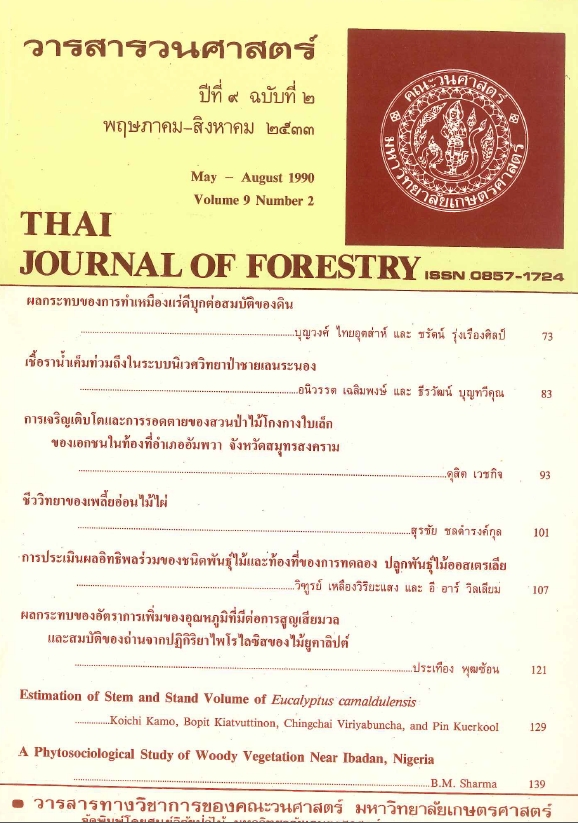A PHYTOSOCIOLOGICAL STUDY OF WOODY VEGETATION Those NEAR IBADAN, NIGERIA
Main Article Content
บทคัดย่อ
The structure and floristic composition of both woody and herbaceous vegetation in the Botanical Garden of the University of Ibadan campus in Nigeria were studied. The area experiences tropical climate having an annual rainfall of 1,740.3 mm and the average mean daily temperature of 25° to 29° C. All the species observed during the point-centered quarter analysis (121 species) and also the others (52 species) were recorded. The vegetation was dominated by phanerophytes. The families represented by the greatest number of species were Leguminosae, Euphorbiaceae, Bignoniaceae, Sterculiaceae and Apocynaceae. The herbaceous vegetation was studied by laying down quadrats, and consisted of 59 species. Based on the Importance Value Index, the woody vegetation was named as Delonix-Elaeis-Lagerstroemia Community while the herbaceous vegetation was Tridax-Synedrella-Pennisetum Community. The association index calculated for the species having the highest frequency with certain other species revealed that Calopogonium mucunoides and Sida acuta were highly associated. Seasonality effect was not marked in the prevailing vegetation.
Downloads
Article Details

อนุญาตภายใต้เงื่อนไข Creative Commons Attribution-NonCommercial-NoDerivatives 4.0 International License.
ข้าพเจ้าและผู้เขียนร่วม (ถ้ามี) ขอรับรองว่า ต้นฉบับที่เสนอมานี้ยังไม่เคยได้รับการตีพิมพ์และไม่ได้อยู่ในระหว่างกระบวนการพิจารณาตีพิมพ์ลงในวารสารหรือสิ่งตีพิมพ์อื่นใด ข้าพเจ้าและผู้เขียนร่วม (ถ้ามี) ยอมรับหลักเกณฑ์และเงื่อนไขการพิจารณาต้นฉบับ ทั้งยินยอมให้กองบรรณาธิการมีสิทธิ์พิจารณาและตรวจแก้ต้นฉบับได้ตามที่เห็นสมควร พร้อมนี้ขอมอบลิขสิทธิ์ผลงานที่ได้รับการตีพิมพ์ให้แก่วารสารวนศาสตร์ คณะวนศาสตร์ มหาวิทยาลัยเกษตรศาสตร์ กรณีมีการฟ้องร้องเรื่องการละเมิดลิขสิทธิ์เกี่ยวกับภาพ กราฟ ข้อความส่วนใดส่วนหนึ่ง หรือ ข้อคิดเห็นที่ปรากฏในผลงาน ให้เป็นความรับผิดชอบของข้าพเจ้าและผู้เขียนร่วม (ถ้ามี) แต่เพียงฝ่ายเดียว และหากข้าพเจ้าและผู้เขียนร่วม (ถ้ามี) ประสงค์ถอนบทความในระหว่างกระบวนการพิจารณาของทางวารสาร ข้าพเจ้าและผู้เขียนร่วม (ถ้ามี) ยินดีรับผิดชอบค่าใช้จ่ายทั้งหมดที่เกิดขึ้นในกระบวนการพิจารณาบทความนั้น”


